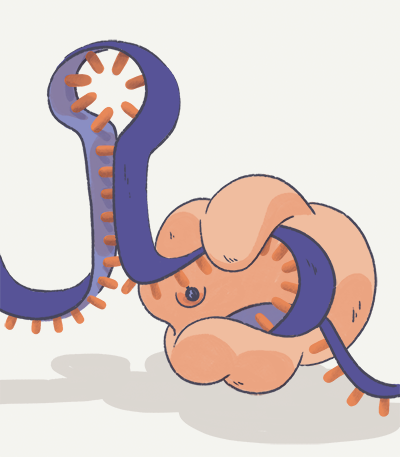Our Research
Most of our ongoing research projects fall under one of these broader themes: RNA modifications and structure; Small- and non-coding RNA biology; RNA in communication and defense; Genomics, epigenomics, and Inheritance; Adaptive plasticity and evolution. Our projects span miRNA biology and pathology, miRNA mechanisms, piRNA biology and the germline, endo-siRNAs in epigenetic inheritance and environmental conditioning, small RNA evolution, and the role of RNAi in host pathogen interactions.
RNA modifications regulate RNA structure, function, and stability. We use various model systems to identify RNA modifications, and to study RNA modifying enzymes and their functions in development and disease.
Selected publications:
- Van Haute L, Lee SY, McCann BJ, Powell CA, Bansal D, Vasiliauskaitė L, Garone C, Shin S, Kim JS, Frye M, Gleeson JG, Miska EA, Rhee HW, Minczuk M (2019) NSUN2 introduces 5-methylcytosines in mammalian mitochondrial tRNAs. Nucleic Acids Res.
- van Delft P, Akay A, Huber SM, Bueschl C, Rudolph KLM, Di Domenico T, Schuhmacher R, Miska EA, Balasubramanian S (2017). The profile and dynamics of RNA modifications in animals. Chem Bio Chem.
Small- and non-coding RNA Biology
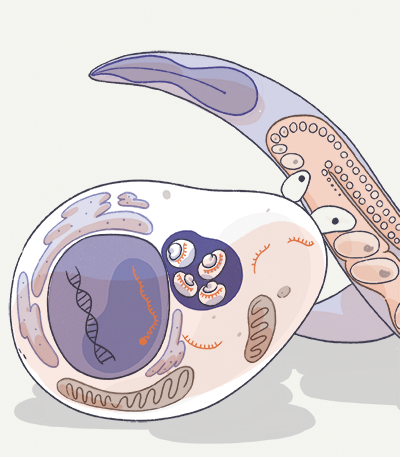
piRNA biology and germline genome stability
piRNAs are animal-specific small RNAs usually restricted to the germline and required for fertility. In 2008 we identified the piRNAs of C. elegans. We have demonstrated that Piwi proteins and piRNAs are important for gemline development and fertility. In the absence of piRNAs, germline genome integrity is compromised and consequently piRNAs have been called “guardians of the genome”. Now we are investigating how piRNAs are generated in the germline and how they act to silence their targets. We are also working hard to understand how the piRNA pathway responds to foreign DNA/RNA and how the pathway is evolving.
Selected publications:
- Weng C, Kosalka J, Berkyurek AC, Stempor P, Feng X, Mao H, Zeng C, Li WJ, Yan YH, Dong MQ, Morero NR, Zuliani C, Barabas O, Ahringer J, Guang S, Miska EA (2019) The USTC co-opts an ancient machinery to drive piRNA transcription in C. elegans. Genes Dev.
microRNAs (miRNAs), a large class of short non-coding RNAs found in many plants and animals, are post-transcriptional regulators of gene expression. Approximately 3% of all known human genes encode miRNAs. Important functions for miRNAs in animal development and physiology are emerging. A number of miRNAs have been directly implicated in human disease. We have generated loss-of-function mutations in almost all of the ~120 known miRNA genes in the nematode Caenorhabditis elegans. This collection provides the only comprehensive resource for the genetic analysis of individual miRNAs to date. Our main goal is to understand the genetic networks underlying miRNA-dependent control. One particular focus is on miRNAs and pathways relating to human cancer.
RNA in communication and defense
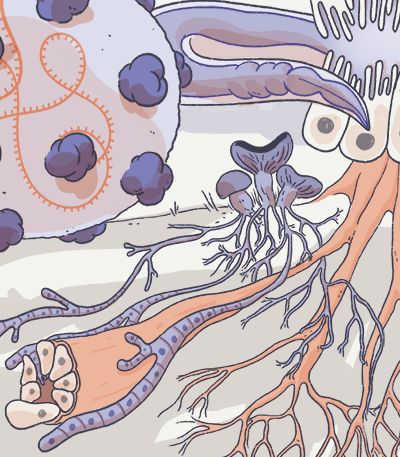
Together with our collaborators Marie-Anne Felix and Dave Wang we recently discovered the first virus to naturally infect C. elegans, a positive-strand RNA virus we named “Orsay”. Positive- strand RNA viruses encompass more than one-third of known virus genera and include many medically and agriculturally relevant human, animal, and plant pathogens. We were able to demonstrate, for the first time, that RNA interference (RNAi) provides immunity to viral infection in animals. Now we are establishing C. elegans/Orsay as a new animal model of host-virus interaction. For example, we recently carried out the first genome-wide association study (GWAS) of virus susceptibility in a wild animal. Using a combined GWAS, quantitative trait loci (QTL) mapping and high-throughput sequencing (HTS) approach we identified a RIG-I homologue (mammalian interferon response), as a major determinant of viral sensitivity.
Selected publications:
- Braukmann F, Jordan D, Miska E, (2017) Artificial and natural RNA interactions between bacteria and c.elegans. RNA Biology.
Genomics, epigenomics and inheritance
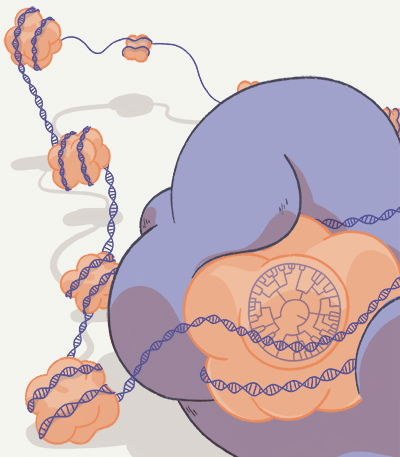
Since August Weismann (1834-1914) formulated the distinction between innate and acquired characteristics at the end of the 19th century, the debate relating to the inheritance of acquired traits has raised many controversies in the scientific community. Following convincing arguments against (e.g. William Bateson) this debate was then set aside by the majority of the scientific community. However, a number of epigenetic phenomena involving RNA, histone modification or DNA methylation in many organisms have renewed interest in this area. Transgenerational effects likely have wide-ranging implications for human health, biological adaptation and evolution, however their mechanism and biology remain poorly understood. We recently demonstrated that a germline nuclear small RNA/chromatin pathway can maintain epi-allelic inheritance for many generations in C. elegans. This is a first in animals and related to “paramutation” discovered over 50 years ago in plants. We are currently further characterizing the mechanisms of paramutation in animals. In addition, we are testing the hypothesis that paramutation provides a transgenerational memory of the environment (“Lamarckism”). We are currently exploring related phenomena in mammals.
Selected publications:
- Van Haute L, Lee SY, McCann BJ, Powell CA, Bansal D, Vasiliauskaitė L, Garone C, Shin S, Kim JS, Frye M, Gleeson JG, Miska EA, Rhee HW, Minczuk M (2019) NSUN2 introduces 5-methylcytosines in mammalian mitochondrial tRNAs. Nucleic Acids Res.
- van Delft P, Akay A, Huber SM, Bueschl C, Rudolph KLM, Di Domenico T, Schuhmacher R, Miska EA, Balasubramanian S (2017). The profile and dynamics of RNA modifications in animals. Chem Bio Chem.
Adaptive Plasticity and Evolution
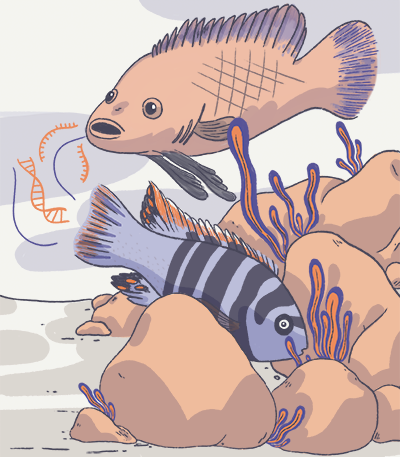
Non-coding RNA and evolution
We know that simple Mendelian disorders can be caused by a wide variety of genetic variants, from single nucleotide point mutations to short insertions and deletions (indels) to larger structural variants. However most research into complex disease has focused on using genetic association methods on single nucleotide polymorphisms (SNPs) in conserved single copy parts of the genome. This overlooks fast evolving structurally variable parts of the human genome, representing perhaps 5-10% of the total sequence, which we know are enriched for functional non-coding sequence. In particular miRNAs evolve rapidly and are often present in multiple and variable copy numbers. We are exploring the contribution of such regions to quantitative traits in a vertebrate model system, focusing in particular on miRNA gene evolution, and develop methods that may potentially be applied to the structurally diverse portion of the human genome. Cichlid fish from the great lakes of Africa present an unparalleled opportunity to study the genetic basis of vertebrate phenotypes in a rapidly evolving system. In the last 5 million years, since humans began to diverge from chimps, African cichlids have radiated into more than 1,500 species that differ in craniofacial morphology, pigmentation, behavior and many other traits. These species can be considered a collection of “natural mutants”, screened by evolutionary selection for phenotypes expressed at all life stages. Because of their close genetic relationship, they share a fundamentally similar genetic system, which allows us to explore the specific genetic differences responsible for their diverse phenotypes. In recognition of this potential five African cichlid genomes were sequenced early in 2011 (Broad Institute). As with other fish genomes, these show extensive structural and copy number variation, even within a single diploid individual. In a collaboration with Richard Durbin we are investigating the genetic diversity and the contribution of copy number variable regions and non-coding RNAs to phenotypic diversity within a set of 100 phenotypically diverse but closely related Malawi haplochromine cichlids by genome sequencing. We expect this work to deliver unprecedented insights into functional non-coding RNAs in general and miRNA/miRNA target interactions in particular.
Selected publications:
- Malinsky M, Svardal H, Tyers AM, Miska EA, Genner MJ, Turner GF, Durbin R. (2018) Whole-genome sequences of Malawi cichlids reveal multiple radiations interconnected by gene flow. Nat Ecol Evol.
- Malinsky M, Challis RJ, Tyers AM, Schiffels S, Terai Y, Ngatunga BP, Miska EA, Durbin R, Genner MJ, Turner GF (2016) Genomic Islands of speciation separate cichlid ecomorphs in an East African crater lake. Science.
- Brawand D, Wagner CE, Li YI, Malinsky M … et al … Miska EA, Lander ES, Venkatesh B, Fernald RD, Meyer A, Ponting CP, Streelman JT, Lindblad-Toh K, Seehausen O, Di Palma F. (2014) The Genomic Substrate for adaptive radiation in African cichlid fish. Nature. 2014, Sept 18. 515, 374-381

